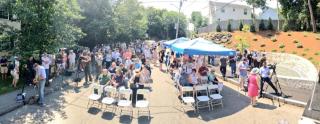Salem Mayor Kim Driscoll’s Remarks at the Proctor’s Ledge Memorial Dedication

On July 19, 2017, Salem Mayor Kim Driscoll was joined by Reverend Jeffrey Barz-Snell of the First Church of Salem, Prof. Emerson Baker of Salem State University, Ward 4 City Councillor David Eppley, and Gail Garda, president of the Towne Family Association, in dedicating the new memorial at Proctor’s Ledge. Proctor’s Ledge is now believed to be the site where 19 innocent individuals were hanged for the crime of witchcraft in 1692. Below are Mayor Driscoll’s remarks, as prepared.
Thank you, Reverend Barz-Snell, and welcome to all joining us today.
Many who are here are descendants of one or more of those nineteen victims wrongfully executed on this site 325 years ago. Many are enthusiasts for our local history, telling the stories and sharing their lessons for future generations to understand and learn from. And many others are, like myself, residents whose families came to Salem long after the trials of 1692. Salem's story is, however, no less their own.
The chapter of that story that took place here, at Proctor's Ledge, 325 years ago, can be a difficult one for us to tell, but that means it's all the more important to do so.
I want to acknowledge and thank the many people who had a hand in the identification of this site: Salem State University Professors Emerson Baker and Peter Sablock; Shelby Hypes of the Salem Award Foundation; Elizabeth Peterson, who is the director of the Jonathan Corwin House, better known as the Witch House; Professor Benjamin Ray of the University of Virginia; and author and historian Marilynne Roach.
I want to also thank all those who worked on the memorial project: landscape architect Martha Lyon who designed the memorial; John Byrne and the team from TPC, who built the memorial and installed the landscaping; Peter Rossi from O'Rourke Brothers Memorials of Salem who did the stone engraving; Leahy Landscaping of Salem and GMH Fence.
And, for the City, my Chief of Staff Dominick Pangallo, who was our point person on the project, Patti Kelleher, our historic preservation planner, our purchasing agent Whitney Haskell, DPW Director David Knowlton and his team, City Electrician John Giardi and his staff, our Community Preservation Committee members and the members of the Parks and Recreation Commission - and the many other city staff and the volunteers who worked on this effort and on today's event.
Finally, my deepest thanks and gratitude go to the families and residents of Pope Street, Proctor Street, and this entire neighborhood. Their lives were turned upside down in a real way when this site was announced and they have demonstrated incredible patience and understanding.
As we gather to dedicate this memorial, it's noon on the date at which the first group execution took place here in 1692. The sun casts few shadows this time of day, and yet the shadows from this place extend across our city in ways we cannot see with our eyes.
The late Elie Wiesel, who spoke so movingly at the dedication of the Witch Trials Memorial here in Salem 25 years ago, once remarked that shadows do not only surround people and objects: "The truth," he said, "is that they also surround words, ideas, desires, deeds, impulses, and memories."
Proctor's Ledge is a place - an object - but it is also an idea. And it is also a memory.
The legacy of what transpired here crosses into the imaginations and consciousness of our community, our Commonwealth, and even our country. It's a legacy that speaks to the need for the rule of law and the impartiality of the judiciary. It speaks to the importance of evidence and science in weighing what is true in our courts, and the importance of inclusivity and compassion in weighing who we are as a society.
The term "witch hunt" has been thrown around pretty freely these days. We should never let that lessen or cheapen what the true and tragic consequences of 1692 were.
Robert Penn Warren once wrote that "history cannot give us a program for the future, but it can give us a fuller understanding of ourselves and of our common humanity, so that we can better face the future."
The shadow from Proctor's Ledge may be long and enduring, but it does not obscure from us that fuller understanding of our common humanity. In fact, it enriches it.
We acknowledge all those who wrongly lost their lives to fear, enmity, and superstition in 1692. We benefit today from a system of jurisprudence and a cultural commitment to tolerance that grows from this place like an oak tree. And, most important of all, we remember.

